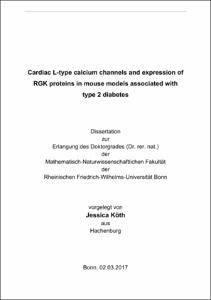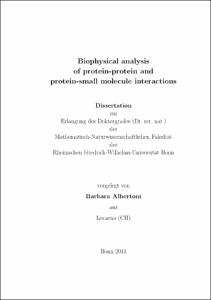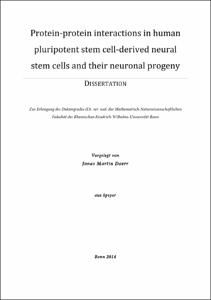Köth, Jessica: Cardiac L-type calcium channels and expression of RGK proteins in mouse models associated with type 2 diabetes. - Bonn, 2017. - Dissertation, Rheinische Friedrich-Wilhelms-Universität Bonn.
Online-Ausgabe in bonndoc: https://nbn-resolving.org/urn:nbn:de:hbz:5n-48800
Online-Ausgabe in bonndoc: https://nbn-resolving.org/urn:nbn:de:hbz:5n-48800
@phdthesis{handle:20.500.11811/7284,
urn: https://nbn-resolving.org/urn:nbn:de:hbz:5n-48800,
author = {{Jessica Köth}},
title = {Cardiac L-type calcium channels and expression of RGK proteins in mouse models associated with type 2 diabetes},
school = {Rheinische Friedrich-Wilhelms-Universität Bonn},
year = 2017,
month = oct,
note = {Introduction: Cardiovascular disease, such as diabetic cardiomyopathy (DCM) and resulting heart failure (HF), is a leading cause of death for diabetic patients.
In ventricles of non-diabetic HF patients, whole-cell L-type calcium current density (ICaL) is unchanged, while the activity of single L-type calcium channels (LTCCs) is increased. These findings suggest changes in both expression and function of LTCCs. In contrast, in a mouse model (db/db) associated with DCM ICaL is reduced, while single-channel activity is unchanged. RGK proteins, like the diabetes-associated Rad, might be involved in LTCC regulation. Though unpublished data suggest that the ventricular expression levels of Rad protein and of the LTCC pore Cav1.2 are positively correlated in several mouse models with diabetes-associated metabolic disturbances, the effect of Rad on cardiac LTCCs in a diabetic context is unclear. The current study aims at elucidating whether there is an unifying mechanism of Rad on LTCCs in diabetic hearts.
Methods: Two of the previously screened mouse models were more thoroughly investigated at an age of 16 and 28 weeks: leptin-deficient obese ob/ob mice and mice lacking insulin receptor substrate 2 (IRS 2). Ventricular ICaL was obtained by patch-clamp recordings and compared to those of wildtype littermates in the context of Rad and Cav1.2 mRNA and protein expression. Rad-knockout (k.o.) mice were investigated to reveal the maximum effect of an in vivo loss of Rad protein on LTCC regulation. In order to further evaluate the role of Rad in ob/ob mice, we analyzed ob/ob mice lacking Rad.
Results: Data obtained from Rad-k.o. mice confirm the inhibitory function of Rad protein on LTCCs and furthermore indicate an age-dependent effect. In older ob/ob mice both, Rad and Cav1.2 expression were significantly upregulated at the protein level, while ICaL was unaltered suggesting a “Cav1.2-antagonistic” function of Rad. ICaL recordings in ob/ob myocytes lacking Rad (ob/ob x Rad-k.o.) further suggest that the role of Rad is similar on a wildtype or an ob/ob background. In younger IRS 2-k.o. mice ICaL was significantly decreased. Since Rad and Cav1.2 protein expression appeared to be unchanged another mechanism underlying the decreased current density has to be assumed. In comparison to younger IRS 2-k.o. mice older mice of the same genotype showed a significantly increased ICaL. The finding that at an age of 28 weeks Cav1.2 protein expression was unaltered, while Rad protein expression was significantly reduced indicates an (age-dependent) loss of LTCC inhibition by Rad in IRS 2-k.o. mice. It is tempting to speculate that this is to compensate for the reduced ICaL observed at younger age.
Summary: The current study indicates an interaction between Rad and LTCCs in two diabetic mouse models. However, there appears to be no uniform, diabetes-associated mechanism of Rad-Cav1.2 interaction possibly explained by differences in the underlying pathomechanisms. The current study confirms the functional relevance of Rad expression. Thus RGK proteins appear to be promising targets to develop therapeutic strategies for the treatment of cardiac diseases involving LTCCs.},
url = {https://hdl.handle.net/20.500.11811/7284}
}
urn: https://nbn-resolving.org/urn:nbn:de:hbz:5n-48800,
author = {{Jessica Köth}},
title = {Cardiac L-type calcium channels and expression of RGK proteins in mouse models associated with type 2 diabetes},
school = {Rheinische Friedrich-Wilhelms-Universität Bonn},
year = 2017,
month = oct,
note = {Introduction: Cardiovascular disease, such as diabetic cardiomyopathy (DCM) and resulting heart failure (HF), is a leading cause of death for diabetic patients.
In ventricles of non-diabetic HF patients, whole-cell L-type calcium current density (ICaL) is unchanged, while the activity of single L-type calcium channels (LTCCs) is increased. These findings suggest changes in both expression and function of LTCCs. In contrast, in a mouse model (db/db) associated with DCM ICaL is reduced, while single-channel activity is unchanged. RGK proteins, like the diabetes-associated Rad, might be involved in LTCC regulation. Though unpublished data suggest that the ventricular expression levels of Rad protein and of the LTCC pore Cav1.2 are positively correlated in several mouse models with diabetes-associated metabolic disturbances, the effect of Rad on cardiac LTCCs in a diabetic context is unclear. The current study aims at elucidating whether there is an unifying mechanism of Rad on LTCCs in diabetic hearts.
Methods: Two of the previously screened mouse models were more thoroughly investigated at an age of 16 and 28 weeks: leptin-deficient obese ob/ob mice and mice lacking insulin receptor substrate 2 (IRS 2). Ventricular ICaL was obtained by patch-clamp recordings and compared to those of wildtype littermates in the context of Rad and Cav1.2 mRNA and protein expression. Rad-knockout (k.o.) mice were investigated to reveal the maximum effect of an in vivo loss of Rad protein on LTCC regulation. In order to further evaluate the role of Rad in ob/ob mice, we analyzed ob/ob mice lacking Rad.
Results: Data obtained from Rad-k.o. mice confirm the inhibitory function of Rad protein on LTCCs and furthermore indicate an age-dependent effect. In older ob/ob mice both, Rad and Cav1.2 expression were significantly upregulated at the protein level, while ICaL was unaltered suggesting a “Cav1.2-antagonistic” function of Rad. ICaL recordings in ob/ob myocytes lacking Rad (ob/ob x Rad-k.o.) further suggest that the role of Rad is similar on a wildtype or an ob/ob background. In younger IRS 2-k.o. mice ICaL was significantly decreased. Since Rad and Cav1.2 protein expression appeared to be unchanged another mechanism underlying the decreased current density has to be assumed. In comparison to younger IRS 2-k.o. mice older mice of the same genotype showed a significantly increased ICaL. The finding that at an age of 28 weeks Cav1.2 protein expression was unaltered, while Rad protein expression was significantly reduced indicates an (age-dependent) loss of LTCC inhibition by Rad in IRS 2-k.o. mice. It is tempting to speculate that this is to compensate for the reduced ICaL observed at younger age.
Summary: The current study indicates an interaction between Rad and LTCCs in two diabetic mouse models. However, there appears to be no uniform, diabetes-associated mechanism of Rad-Cav1.2 interaction possibly explained by differences in the underlying pathomechanisms. The current study confirms the functional relevance of Rad expression. Thus RGK proteins appear to be promising targets to develop therapeutic strategies for the treatment of cardiac diseases involving LTCCs.},
url = {https://hdl.handle.net/20.500.11811/7284}
}









